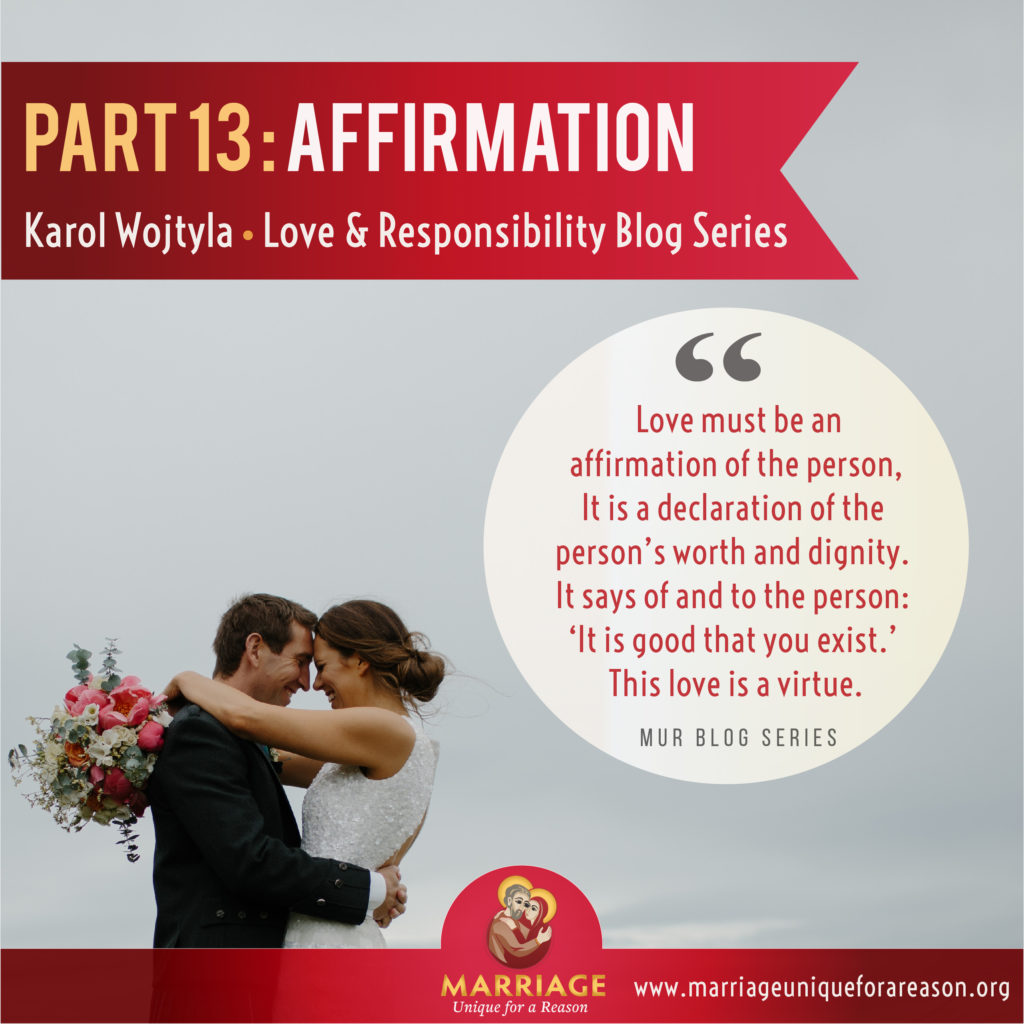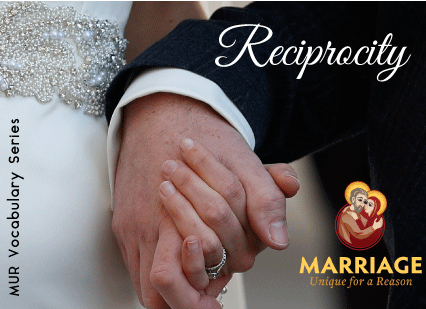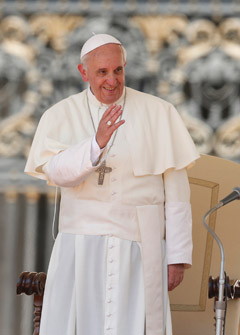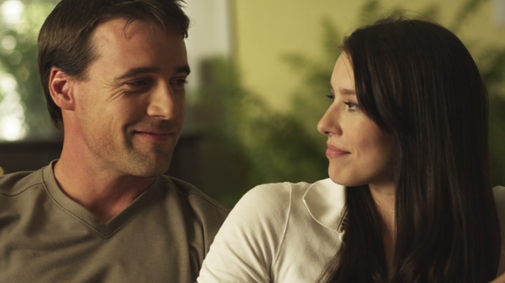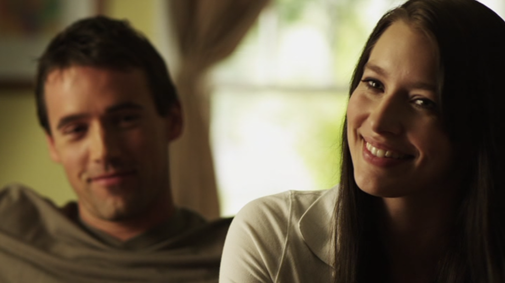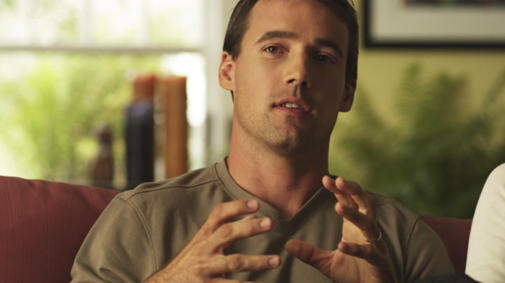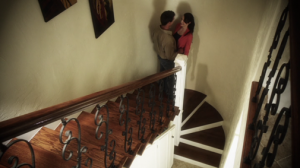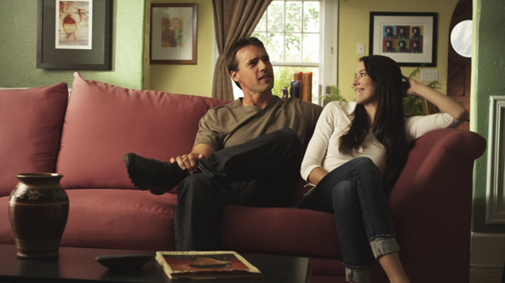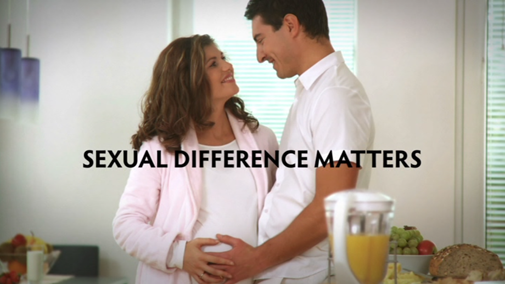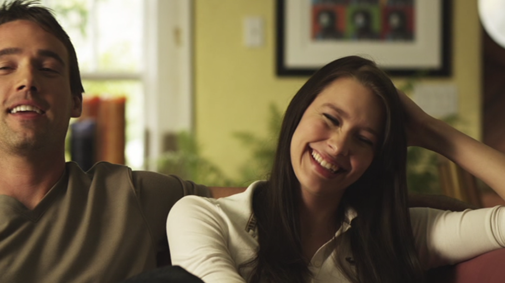Affirmation: Love and Responsibility Series (Post #13)
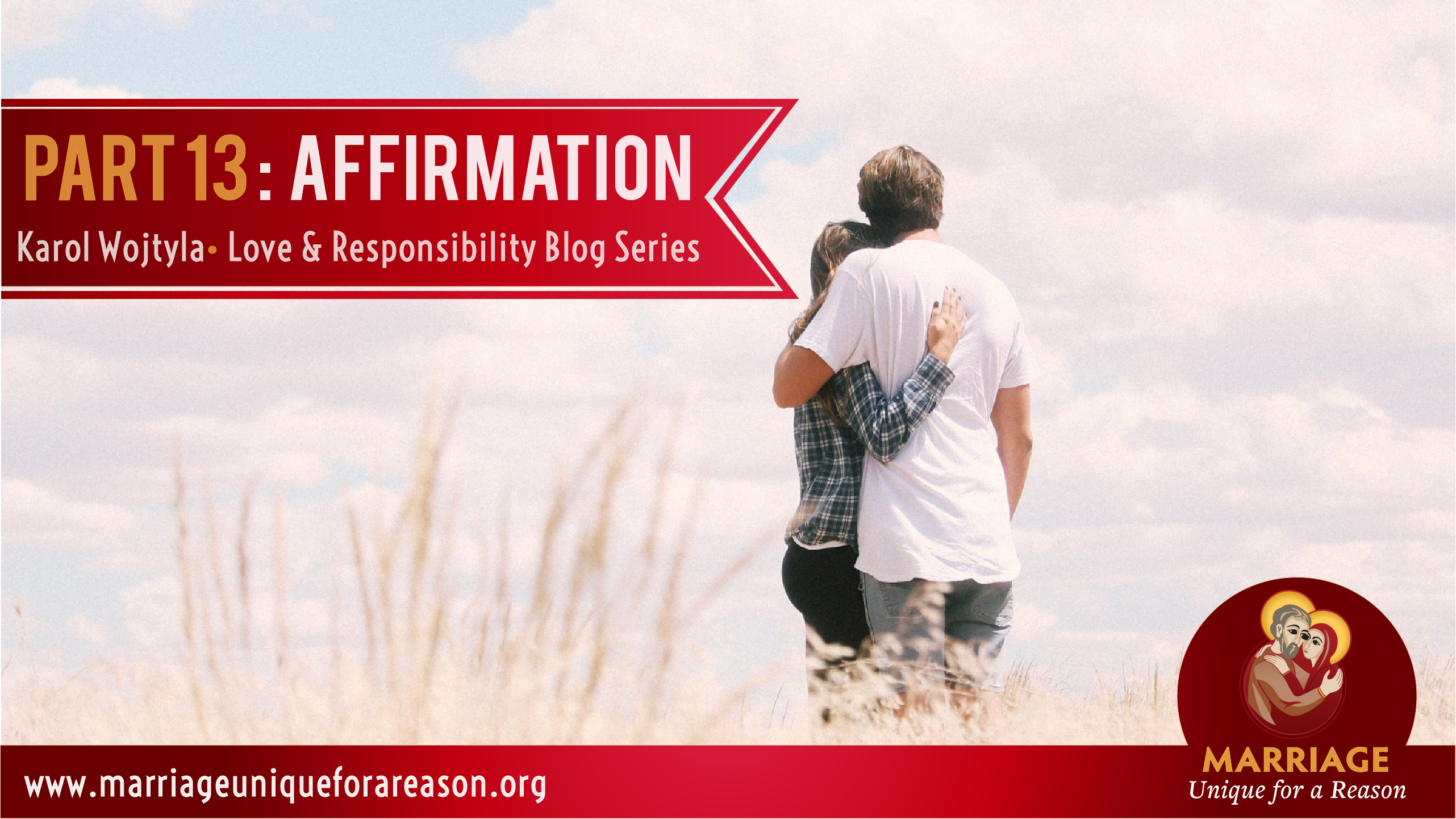
The Inherent Value of the Human Person
Karol Wojtyla reminds us in this section of Love and Responsibility that a person has worth beyond any other created thing or object in the world. A person has an inner life (spirit) and is capable of spiritual perfection (in heaven). The inherent value of every human person goes far beyond any quality that they may possess (such as beauty, brains, or brawn). [This is one reason that racism is clearly an evil, since it reduces the value of the person due to an accidental[i] quality.] The human person has unique dignity because he or she is made in God’s image and called to communion with him. 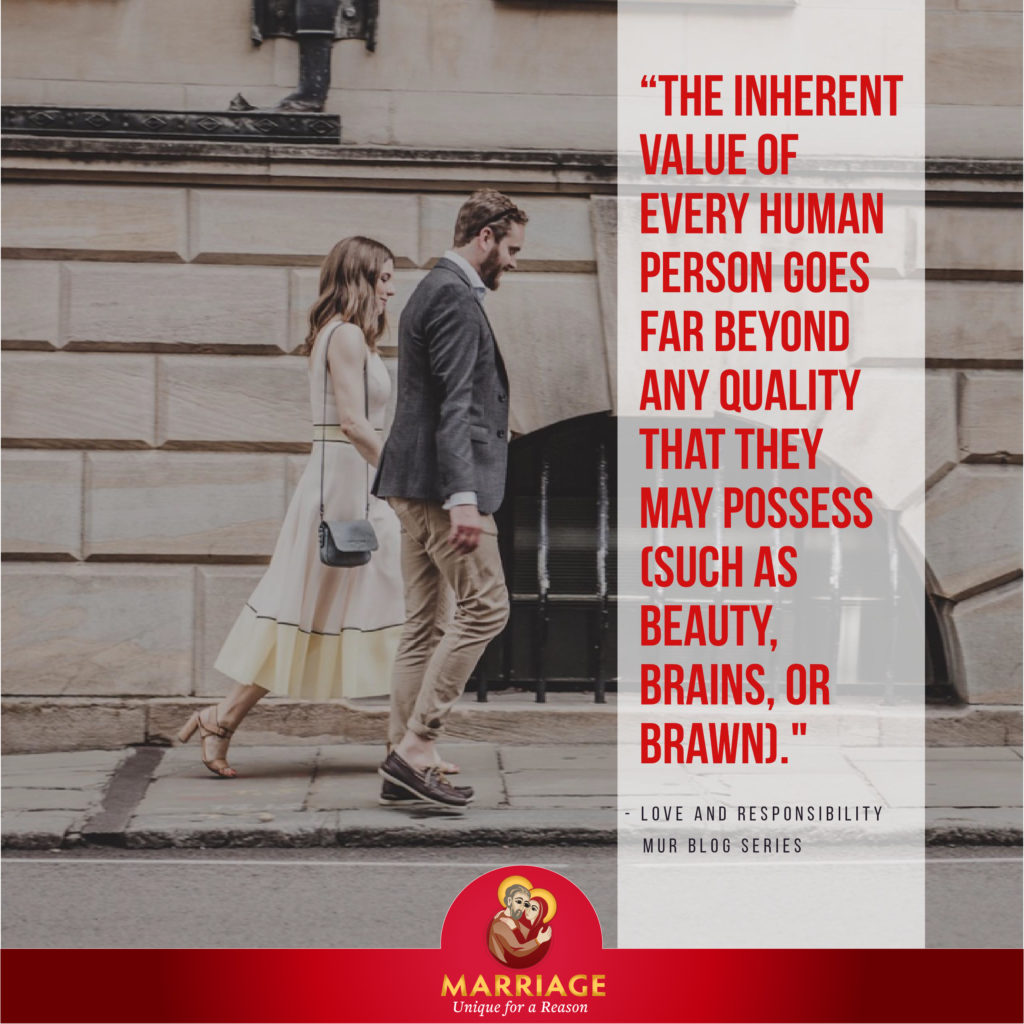
“That being so,” Wojtyla writes, “every person of the opposite sex possesses value in the first place as a person, and only secondarily possesses a sexual value.”[ii] Everyone is a person first, man or woman second. Experientially, when a man meets a woman, he typically sees her as a woman (and vice versa, when a woman meets a man, he registers as “male”) but the fact that the other is a person, “demands that the sensual and emotional reaction to a ‘human being of the other sex’ be somehow adjusted to the knowledge that the human being concerned is a person.”[iii] Harry isn’t just some kind of incarnation of maleness, and Sally isn’t just some beautiful piece of art to gaze at; they are persons whom God loves.
The Affirmation of the Person
Love must be an affirmation of the person, per Wojtyla; It is a declaration of the person’s worth and dignity. It says of and to the person: “It is good that you exist.” This love is a virtue, an “authentic commitment of the free will of one person… resulting from the truth about another person.”[iv] Affirmation of the person is connected with the other aspects of love (sensuality, emotion) but not reducible to them. The full truth of the person—with his or her faults and weaknesses as well as virtues and gifts—must be seen and accepted by the one who truly loves. 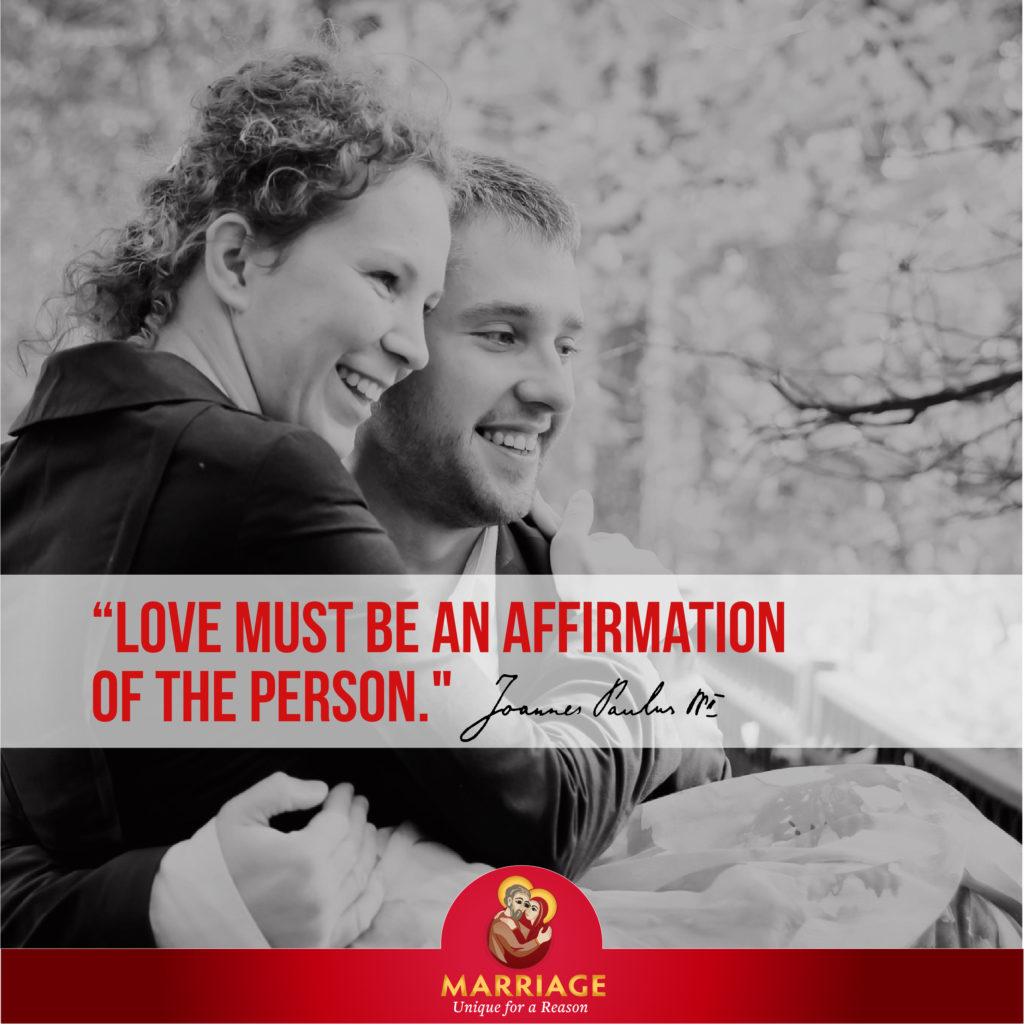
Learning this virtue of charity/love by focusing on affirming the person leads to two other developments in a person’s life. One is growth in the virtue of chastity, exhibiting self-control over one’s sensual and emotional reactions. Second is the discernment of one’s vocation or state in life (marriage or celibacy for the Kingdom). Both states in life are based on the call to love—to affirm every person—in a particular way.
In the next section, Wojtyla continues contemplating the necessity of marital love to be both subjective and objective, repeating much of what has been said before. He talks of what it takes for two people to belong to one another in love. A point he reiterates from earlier is the necessity of each person to know their own worth and dignity as a person before entering a relationship. “A woman is capable of truly making a gift of herself only if she fully believes in the value of her person and in the value as a person of the man to whom she gives herself.”[v] This can be assumed to be reciprocal. One of the challenges of love between a man and a woman is each internalizing that he or she is worthy of it.
[i] Please note the use of the term “accidental” in its philosophical meaning as un-essential, or not determinative of the thing’s nature. For example, for a cat, having long fur is an “accident” while being a creature with four paws and a superiority complex is essential.
[ii] Wojtyla, Karol. Love and Responsibility (San Francisco: Ignatius Press, 1993), p. 122.
[iii] Ibid, p. 123, emphasis original.
[iv] Ibid, p. 123.
[v] Ibid, p. 129.
Archive
What Is Marriage All About?
The final section we are going to discuss from Made for Each Other has to do with what is traditionally called the two “ends” (or purposes, reasons for existing) of marriage. The Church teaches that because marriage is the total gift of one spouse’s life to the other, it entails both the gift of love and the gift of children. Marriage is the gift for life and the gift of life. It’s unique and irreplaceable—the fundamental institution for life.
The Church affirms that the love of husband and wife is a great good in and of itself, even if they do not receive the gift of a child. Human marriage is a foreshadowing of the marriage between Christ and his Church and sacramental marriage participates in and shows forth this love (see Eph 5:28-33).
Marriage lived in truth is an indispensable model of communion for the world and an affirmation that life is good. The love of husband and wife reminds us all that no one is an isolated individual, that we need one another at the most fundamental level. This love is meant to be the context for welcoming, forming, and educating new life. This is why marriage, as a personal relationship, has always been recognized to have great, public significance. The love of spouses, the responsibilities of mothers and fathers, and the rights of children—all are tied to the unique truth of marriage and its protection and promotion.
The Church will never waver in her teaching that marriage is the lifelong union of a woman and a man, open to life. From the beginning, man and woman are made for each other. There is nothing else like it.
Discussion questions:
- How is marriage the “gift for life” and the “gift of life”?
- The public proposal to “redefine” marriage to include persons of the same sex is fairly recent. How is it connected to a larger confusion around the meaning of the person and sex?
- How is this meaning inseparable from the truth of marriage as the union of one man and one woman?
***
For this reason a man shall leave his father and mother and be joined to his wife, and the two shall become one flesh. (Mt 19:5)
Archive
What Are These Differences?
In this section of Made for Each Other, Josh and Carrie explore what sexual difference may look like in a given couple. Men and women are, as Carrie puts it, “different in ways that will always matter.” Biology is important, but the body and the person are not reducible to biology. Sexual difference involves the whole person, body and soul.
The body reveals the person. We’re not souls trapped in bodies. We’re “body-persons.” We don’t just have a body. We are our bodies. (We even have words for people who are without one or the other—a corpse is a body that is missing a soul; a ghost is (perhaps) a soul missing a body.) The body of a man and the body of a woman are distinct, personal realities. In addition, as Pope St. John Paul II taught, these bodies have a “spousal meaning.”[i] The body, in its masculinity or femininity, reveals that we are persons who are made to be a gift to others and to be received as a gift by others.
Every human person shares the same nature (human) and the same dignity, made in the image of God. Our sexual identity as a man or a woman is the way in which that humanity is manifested. This identity is meant to be acknowledged and accepted as a gift from God.[ii] It has significance for all the various ways we relate to others: we are a daughter or a son, a sister or a brother, a mother or a father.
While some play down the reality of sexual difference or limit it to the differences between female and male anatomy, sciences such as neurobiology, evolutionary psychology, endocrinology, histology, and reproductive physiology—to name a few—point to the intricate, unique, and complementary physiologies of women and men. We may have conversations differently; take risks differently; form and process relationships differently; respond to threats differently. These differences do not imply that one sex is superior to the other. Men and women are just different. Admitting this does not diminish either sex but serves to enhance the possibility of their unity in love.
Of course, men and women differ among themselves, as well as differing from each other. Sex differences in each and every trait need not be present in each and every individual woman or man. But the way a trait is lived out will always be distinct, whichever person, man or woman, is exhibiting it. For example, the way that St. Joan of Arc was a soldier was not the same as a man’s way.
Our gender, which can be distinguished but not separated from our sex,[1] is a fundamental “given” in our lives. Male and female are two different ways of being human, body and soul.
Discussion questions:
- What does it mean to say that “the body reveals the person”?
- How do equality and difference go together when speaking of man and woman? How does complementarity depend upon difference?
[1] See Amoris Laetitia, no. 56.
[i] See TOB, 13:1–16:2. See also Pope John Paul II’s Familiaris Consortio, no. 37, and Veritatis Splendor, no. 15.
[ii] See CCC, nos. 2332-2333.
Archive
Sexual Difference Does Not Compete, It Complements
In our second clip from Made for Each Other, Carrie ends with the comment, “Our sexual difference doesn’t compete; it complements.” Sexual unity and the coming-to-be of babies depend on the difference between man and woman. The husband gives his whole self (body, mind, heart, soul) to his wife; the wife gives her whole self to her husband. This happens in a particularly clear and dramatic way when the gift of the body is offered in marital intercourse. The spouses give themselves and receive each other in and through their difference. As Josh says, “every natural process of the body” can be done by oneself—“everything but making love and having children,” which depends upon the other person being different. Sexual difference is the avenue towards real union, a union that is also open to life.
Sexual difference concerns the whole person, as Carrie points out. Only through this difference can a man and a woman give themselves fully and love each other as spouses. This isn’t unjust discrimination; it’s an actual distinction, a matter of reality. Sexual intercourse in marriage is a way of communicating, it is a language spoken face-to-face. Part of the essential grammar of this language is sexual difference. Without it, marriage can’t be spoken of.[i]
Men and women are equal and different. Difference is a great and necessary good. “It’s constructive,” as Josh says. Sexual difference is what enables a man and a woman to form a unique bond for life, a union that is deeper than friendship and lasts until death. A husband gives to his wife what only a husband can give. Likewise, a wife gives to her husband what only a wife can give. And together, they give the world new life!
Discussion questions:
- Do you think sexual difference is understood and appreciated today? Why or why not?
- How can we help others reflect on the importance of sexual difference and complementarity?
[i] This is also why sex outside of marriage doesn’t make any sense. Sex itself speaks a language of total commitment and gift—faithful and indissoluble love. That’s the language of marriage. Sex outside of marriage always says something that is untrue. It’s pretending. Real love depends on truth, and truth depends on love (see Pope Benedict XVI, Encyclical Caritas in Veritate [Washington, DC: USCCB, 2009], nos. 1-9).
Archive
Made “For Each Other”
In this segment of the video, Josh and Carrie discuss the way that marriage is not like being roommates who live together, but separately. Man and woman are made for each other in a way that is absolutely unique. We see this through their sexual difference, even if we just look to the human body as male or female. A man’s body does not make sense by itself, nor does a woman’s; only together is it possible to get the whole picture of humanity. At a deeper level, as Josh says in the video, there is also a longing of the one for the other. There are always and only two ways of being human[1]: we cannot be the other, so we want to be with the other.
We are made for union and communion, to be in relation with others.[i] In Genesis, God says, “It is not good for the man to be alone” (Gn 2:18). God’s solution to man’s isolation is not to create another identical man. Rather, He creates a woman from the man’s side and gives the two to each other in the first marriage. “For this reason, a man shall leave his father and mother and be joined to his wife, and the two shall become one flesh” (Mt 19:5; cf. Gn 2:24).
The two become one flesh in the physical act of sexual intercourse, in which the bodies of the man and woman cooperate in an act which may bring about the procreation of another human being. As Eve says, “I have produced a male child with the help of the LORD”(Gn 4:1). There is only one “combination” of human bodies that can produce new life: a man and a woman. If you accept the idea that human life has special value, then you should also accept that the (one and only) natural action that can bring this life into existence is, by that fact, unique in its power and importance to the world.
The truth of the human person, created male and female, and the truth of what marriage is, are not only concerns of religion or religious people—they are truths that affect everyone.
Discussion question:
- Why is it important to society that marriage be based on sexual difference?
- Why is the fact of our being created male and female not simply a tool for the survival of the species?
[1] Even in those rare cases of atypical genetic or physical development, the fundamental question is whether the person is male or female. There are only “X” and “Y” chromosomes, there is no “other” sex. In such cases, we rely on natural science that can help determine biological sex. This knowledge will help the person to understand his or her sexual identity.
[i] See CCC, nos. 45, 371-372, 1603-1604, and 1877-1879.
Archive
Made for Each Other: Short Segments for Study
Introduction
But God did not create man a solitary being. From the beginning “male and female he created them” (Gn 1:27). This partnership of man and woman constitutes the first form of communion between persons.
–Second Vatican Council, Pastoral Constitution Gaudium et Spes (1965), no. 12[i]
What is marriage?
The question of what marriage is has been largely ignored in debates about who can get married. Before asking who can get married, one should ask what “marriage” is. What is this relationship that two (or more) people want the state to recognize, and why should society care about it?
Let’s see what definitions are out there and how they measure up to what we all kinda-sorta-in-our-bones know about what marriage is.
Google: the legally or formally recognized union of a man and a woman (or, in some jurisdictions, two people of the same sex) as partners in a relationship.
“Union… as partners in a relationship.” Well, what kind of relationship? What about business partnerships or siblings? What kind of union?
Merriam-Webster: a (1): the state of being united to a person of the opposite sex as husband or wife in a consensual and contractual relationship recognized by law (2): the state of being united to a person of the same sex in a relationship like that of a traditional marriage <same-sex marriage>
This one is interesting because, as you see, the authors have to resort to comparing “the state of being united to a person of the same sex” as being like “traditional marriage” in order to explain it. It’s definitely better than Google’s definition, since it gets to the parties “being united… in a consensual and contractual relationship” but once again, we could say that the same would apply to different kinds of “consensual and contractual relatinoships”.
Oxford Dictionary: The legally or formally recognized union of two people as partners in a personal relationship (historically and in some jurisdictions specifically a union between a man and a woman).
This is probably the most accurate definition of the way the majority of people understand marriage today: “union of two people as partners in a personal relationship.” It is worth asking, then, why the government has any interest in personal relationships.
It seems like all these definitions lack something.
If you really take the time to think about the definition of marriage, you will discover that there is only one definition of marriage that truly fits with who we are as human beings (body and soul, male and female) and seems to get at what is fundamental: marriage is the lifelong, exclusive union of one man and one woman, open to life.[ii]
This definition expresses what marriage is when it is lived truly, and this is a grace available to every married couple. But in this world of brokenness, we have all witnessed a general weakening of people’s understanding and living out this truth. The cultural and legal connections among marriage, sexual intercourse, childbearing, and childrearing have been slowly chipped away at, whether through acceptance of extra-marital sex and cohabitation on the one hand, or third-party reproduction on the other. One can easily see that our society as a whole has lost a consciousness of what men and women are called to be for one another.
God’s vision and plan for marriage is an ideal but it is not idealistic. As Pope Francis taught in Amoris Laetitia, “in no way must the Church desist from proposing the full ideal of marriage, God’s plan in all its grandeur.”[iii] And again, he writes, “Married couples are grateful that their pastors uphold the high ideal of a love that is strong, solid, enduring and capable of sustaining them through whatever trials they may have to face.”[iv] Marriage is a communion of persons, a communion of love between husband and wife, meant to be the source of the family and society. That’s why, when the Pharisees questioned Jesus about divorce, He refered back to creation, when Adam and Eve were given in relationship to one another for life (see Mt 19:4-6; Mk 10:6-8).[v]
The series we are beginning on the MUR blog next week accompanies short segments of the video Made for Each Other. In this video, actors playing Josh and Carrie discuss the importance of sexual difference to marriage and the complementarity between man and woman. During these four weeks, we will explore these themes a bit more. Much of the posts will contain text found in the Viewer’s Guide of Made for Each Other. The questions provided can be used for personal reflection or for group discussion.
[i] See Austin Flannery, ed., Vatican Council II: Volume 1: The Conciliar and Post Conciliar Documents, new rev. ed. (Northport, NY: Costello Publishing, 1996).
[ii] See CCC, nos. 1601-1605.
[iii] Amoris Laetitia, no. 307.
[iv] Amoris Laetitia, no. 200.
[v] See Pope John Paul II, Man and Woman He Created Them: A Theology of the Body (TOB), trans. Michael Waldstein (Boston: Pauline Books & Media, 2006), 1–4 (audience numbers); Pope John Paul II, Encyclical Veritatis Splendor (Washington, DC: USCCB, 1993), nos. 22 and 53.
Archive
Vocabulary Term: Reciprocity
The word “reciprocity” originated in the middle of the 18th century, from the Latin word meaning “moving backward and forward.”[i] It is defined in the Oxford English Dictionary as “The practice of exchanging things with others for mutual benefit.”[ii]
Reciprocity is a frequently-used term when referring to the relationship between the sexes. Many theologians, in particular, pair it with the word “asymmetrical,” so today we will look at these two words together.
Human beings like to have reciprocal relationships. With our relatives, friends, and particularly spouses, we do not like to feel as if one person does all the “giving” and the other all the “receiving,” (or, more cynically, the “taking”). We want to experience our relationships as balanced—even if our idea of balance does not match up with that of other people or society at large. Reciprocity means, in relationships, that there is a giving and a giving-back in love. As the actor in Made for Each Other says, marriage is not 50-50, it’s 100-100. But imagine if one spouse, Jack, feels they are giving 100% in the relationship, and the other, Jill, suspects that Jack is really only giving 75% of his effort into it, holding back on X, Y or Z. Trouble is bound to follow.
When I was in high school, I remember getting frustrated with my parents’ relationship, in which, from my perspective, my mom “did everything.” According to my enlightened (i.e., teenaged) mind, their relationship lacked reciprocity. Years later, I found out that my parents did not see it that way. My mom’s doing the chores was her way of showing love (acts of service), which is not the same as my dad’s.[iii] This is a reminder that reciprocity in a relationship cannot be measured from the outside.
Add “asymmetrical” to “reciprocity” and you have a closer approximation of the love of God. He always gives first. Our relationship with Him is always asymmetrical in that way. When we give to God, it is in response to Him who loved us first—“In this is love: not that we have loved God, but that he loved us and sent his Son as expiation for our sins” (1 John 4:10).
Marriage is also asymmetrical in a number of ways, many of which are based on sexual difference. The most obvious example is that of childbearing. It is indisputable that the woman gives more of herself to the infant for the nine months of gestation and a certain length of time after birth than the man does. This is not “fair” or “equal”; it may not even seem “complementary” since there is not really a parallel for the man. But it can (and must) be integrated into a relationship of reciprocity, albeit “asymmetrical”. A husband can certainly respond to the needs of his wife, especially after having a child, by supporting and encouraging her in any number of ways. Meanwhile, a man may be able give more of himself in some other way. For example, traditionally it is the man who kneels down to ask a woman to marry him; in this way he is imaging an “asymmetrical” type of love, a love that takes the first step and places itself at the service of the other. Marriage is full of little imbalances which, paradoxically, result in true balance.
[i] “Reciprocity.” Oxford Dictionaries. http://www.oxforddictionaries.com/us/definition/american_english/reciprocity (accessed February 23, 2016).
[ii] Ibid.
[iii] If you’ve never heard of the 5 love languages, check out Gary Chapman’s book, The Five Love Languages.
Archive
Pope Francis Homily for Wedding
On the Feast of the Exaltation of the Holy Cross (September 14, 2014) the Holy Father received the vows of 20 couples, joining in the Sacrament of Marriage. This is an excerpt from his homily, highlighting the beauty of sexual difference:
“The love of Christ, which has blessed and sanctified the union of husband and wife, is able to sustain their love and to renew it when, humanly speaking, it becomes lost, wounded or worn out. The love of Christ can restore to spouses the joy of journeying together. This is what marriage is all about: man and woman walking together, wherein the husband helps his wife to become ever more a woman, and wherein the woman has the task of helping her husband to become ever more a man. This is the task that you both share. “I love you, and for this love I help you to become ever more a woman”; “I love you, and for this love I help you to become ever more a man”. Here we see the reciprocity of differences. The path is not always a smooth one, free of disagreements, otherwise it would not be human. It is a demanding journey, at times difficult, and at times turbulent, but such is life!”
Archive
How to use Marriage: Unique for a Reason (7th of 7 in a series)
Note: This post is seventh in a series of posts about what we can learn from the Supreme Court’s June 2013 DOMA decision, and how that can help us better promote and defend marriage. This series is based on a July 2013 talk by staff of the USCCB Subcommittee for the Promotion and Defense of Marriage.
Earlier posts:
- #1: Background to the Supreme Court cases
- #2: Unspoken assumptions & reframing the debate
- #3: What do you say that marriage is? The need for a comprehensive vision
- #4: The flawed anthropology of “sexual orientation” and the need for a renewed emphasis on anthropology and chastity
- #5: Is defending marriage just about injuring others? No. Marriage matters for everyone.
- #6: What now? Practical ways to promote and defend marriage
————————————————————————————————-
PART TWO: Practical ways to promote and defend marriage
Post #7: How to use Marriage: Unique for a Reason
The audience that the bishops have in mind for the Marriage: Unique for a Reason project is Catholic young adults. The bishops reasoned that young adults are most bombarded and most susceptible to faulty messages about marriage, but the materials could certainly be used for older audiences too. The materials do not assume much in the way of prior catechesis, but they are written for a Catholic audience, not a generic or secular one.
The end-goal of the resources is inculcating a renewed understanding and appreciation of what the Church teaches in regards to marriage, and a sense of its reasonableness. The hope is that learning the Church’s timeless teaching can build confidence to promote and defend it.
The videos themselves are meant as a kind of “artistic introduction” to the topic that can spark questions and comments from the viewers. The written guides that accompany the videos can help “train the trainers” to get the right content to be confident in facilitating and answering questions. For example, the comment in Made for Each Other – “It’s not just about biology…” could open the discussion to talking about sexual difference as greater than just anatomy, about the spousal meaning of the body, about the role of science, etc. Or the line in Made for Life – “My husband plays in a way I don’t” – could lead into talking about the unique gifts of fathers and mothers and how sexual difference is more than different “roles.”
There are many settings in which to implement the Marriage: Unique for a Reason resources. Here are a few:
- Host a small-group event where you show one or more of the videos and lead a discussion.
- The videos also work well in a classroom setting, and are something that high school teachers or college professors could use with the same aim in mind. They can be used in RCIA as well.
- In the marriage preparation or enrichment setting, the videos could be used to help the participants gain a better understanding of their own marriage and how sexual difference matters to them. The leader might guide the discussion in that direction.
- The videos could also be helpful when you are training volunteers, for marriage prep or NFP, etc., to help them become more confident in what the Church teaches so that they can best help others.
Fundamentally, the videos and their companion resources are meant to “break open” the questions that need to be asked in the marriage debate: what is marriage? Why does sexual difference matter? What does marriage bring to society? And they aim to do that in a non-confrontational, invitational way.
Other ways you could use the Marriage: Unique for a Reason materials is to include one FAQ from the website in your newsletters or other communications. Or compile several for a simple bulletin insert or handout, and direct people to the website for more information.
Collaborate…and pray!
The final “tip” we’d like to offer is something that we’ve learned over the past year in our work at the USCCB, and that is the importance of collaboration and the key importance of prayer. Specifically, we’ve helped to develop and promote the Bishops’ Call to Prayer for Life, Marriage, and Religious Liberty, which began in December 2012 and is ongoing. The bishops urge Catholics to pray and fast for the causes of building a culture of life and marriage, and gaining religious protections. In particular, they encourage praying a daily rosary, attending adoration monthly, fasting and abstaining from meat on Fridays, and there are special petitions that can be read at mass, in English and in Spanish. The second annual Fortnight for Freedom (June 21 – July 4, 2013) was the 5th component of the Call to Prayer.
We’ve collaborated with several offices in furthering the Call to Prayer, particularly the pro-life office and religious liberty office. This was important not just because it shared the workload, but because these issues are tied together. Marriage is the “sanctuary of life,” and a pro-life society is a strong marriage society and vice versa. And as we’ve already talked about, marriage and religious liberty are strongly linked together.
We encourage you to reach out to others in your diocese or region who are doing pro-life or religious liberty work and find ways to collaborate together. There is strength in numbers, and it’s so important, for example, to encourage pro-life folks to promote and defend marriage, and vice versa. (This would include your State Catholic Conference, particularly with regard to policy issues and aiding in communicating it to the faithful.) One idea is to host a seminar with the relevant offices – marriage and family life, pro-life, State Catholic Conference, etc. – on how catechesis and policy/advocacy work together.
The Call to Prayer also witnesses to the fact that prayer is key. Fundamentally, the battle is spiritual, and it’s a battle for souls. Prayer and fasting are essential, not optional. That is the vision behind the Call to Prayer – that we do what we can, but it is God who changes hearts and minds. We encourage you to check out the Call to Prayer website: www.usccb.org/life-marriage-liberty. There you can read about the five ways to participate and can sign up to receive weekly reminders to fast on Fridays, along with a different intention and reflection each week. There are also web banners to put up on your own website.
Archive
What now? Practical ways to promote and defend marriage (6th of 7 in a series)
Note: This post is sixth in a series of posts about what we can learn from the Supreme Court’s June 2013 DOMA decision, and how that can help us better promote and defend marriage. This series is based on a July 2013 talk by staff of the USCCB Subcommittee for the Promotion and Defense of Marriage.
Earlier posts:
- #1: Background to the Supreme Court cases
- #2: Unspoken assumptions & reframing the debate
- #3: What do you say that marriage is? The need for a comprehensive vision
- #4: The flawed anthropology of “sexual orientation” and the need for a renewed emphasis on anthropology and chastity
- #5: Is defending marriage just about injuring others? No. Marriage matters for everyone.
————————————————————————————————-
PART TWO: Practical ways to promote and defend marriage
Post #6: Doing your ministry well, and Marriage: Unique for a Reason
The current challenges we face in regards to marriage, as evidenced by the June 2013 Supreme Court decisions on two marriage cases (regarding DOMA and Proposition 8), does not mean that you have to fundamentally shift gears in your ministry or – worse – start several new programs to address these issues! That’s not what we’re suggesting, although we are going to tell you about what resources the USCCB has to offer that you may find helpful.
Instead, we encourage you to think about how the ministry you are doing right now can more effectively combat the growing sense that gender is irrelevant to marriage, and all the faulty anthropology that goes with that.
For example, perhaps a marriage preparation program could more intentionally teach the engaged couples about the distinct gifts of men and women, mothers and fathers. It could help them see the uniqueness of their roles as husbands and wives. Or perhaps in programs for young adults or even high school students, you could integrate more teaching on chastity and Christian anthropology, especially the theology of the body. We know many of you have been doing this yet so much more needs to be done.
We know you are abundantly aware that the people you serve are not coming to you as a “blank slate,” as it were, and have already been heavily influenced by the ideas we spoke about earlier, that the Supreme Court put so clearly for us. Being “neutral” toward marriage redefinition is no longer an option; being proactive is. Defending and promoting marriage go hand in hand, and while not everyone is called to engage in public policy advocacy work, all of us can intentionally promote and defend the uniqueness of marriage and help people see and articulate alternative responses to the dominant cultural messages on marriage.
Marriage: Unique for a Reason
One specific resource that may be of help to you in your ministry is the bishops’ initiative Marriage: Unique for a Reason. I imagine that many of you are somewhat familiar with this resource already, and may have already used it in your ministries.
Marriage: Unique for a Reason has four themes: sexual difference and complementarity, the gift of children and the need for fathers and mothers, marriage and the common good, and marriage and religious liberty. The order is important. The series starts with sexual difference because that is the most fundamental component – and the one most often overlooked – of marriage’s meaning. Starting with sexual difference helps to get at the roots of the issue and address the often unspoken assumptions. It also provides a solid anthropological grounding for the other three themes.
The video about sexual difference is called “Made for Each Other.” Like all of the videos, it comes with a Viewer’s Guide and a Resource Booklet for priests, deacons, catechists, and leaders.
The second theme is about children and the need for fathers and mothers. This theme includes examining what fruitfulness is and why it’s at the heart of marriage. It considers the often overlooked justice issue in the marriage debate: justice for children, to have the best chance at having a mom and a dad. It also addresses the issues of infertility and single parents (see FAQs #3 and #5). The video for this theme is called “Made for Life.” It also comes with a Viewer’s Guide and Resource Booklet.
The third theme, marriage and the common good, relies heavily on Catholic Social Teaching about marriage and the family and their contribution to society (see FAQ #5). It also aims to reframe the debate about equality, rights, and so on, by reinforcing the inherent goodness of marriage for everyone in society (see FAQ #13). The video in this theme is forthcoming, but there are already FAQs available at Marriage Unique for a Reason.org.
The fourth and final theme, marriage and religious liberty, addresses the fact that redefining marriage in the law directly affects religious liberty (see FAQ #3). This video is also forthcoming, but FAQs are available.
And lastly, there is one video in Spanish – to be released later in 2013 – that incorporates all four themes in a longer, dramatic style. It’s called “El Matrimonio: Hecho para el amor y la vida” (Marriage: Made for Love and Life). The final version will be subtitled in English, and the accompanying Study Guide will be bilingual, so these resources will be suitable for mixed-language audiences.
I already mentioned the website: Marriage: Unique for a Reason.org. On that site are many FAQs about marriage, a regularly updated blog, a library of Church teaching, and more. We are in the process of updating the website to be more user-friendly and easy to navigate.
Next: Post #7: How to use Marriage: Unique for a Reason (and the importance of prayer)
Archive
Archbishop Cordileone's Presentation on Marriage at the Bishops' General Assembly
The U.S. bishops met at their bi-annual plenary assembly in Baltimore this week, November 12-14. On Monday, November 12, Archbishop Salvatore Cordileone, chairman of the Subcommittee for the Promotion and Defense of Marriage and Archbishop of San Francisco, gave an oral report to the bishops on the work of the Subcommittee. His address touched on both catechetical initiatives and public policy advocacy work.
Marriage and the New Evangelization
The Archbishop began by referencing Pope Benedict XVI’s homily on October 7, where the Holy Father linked marriage and the New Evangelization. “Matrimony is a gospel in itself, a Good News for the world of today,” the Pope said. “Marriage is linked to faith, but not in a general way…There is a clear link between the crisis in faith and the crisis in marriage…Marriage is called to be not only an object but a subject of the new evangelization.” Archbishop Cordileone commented that Pope Benedict’s words are “sobering but also encouraging.” He added, “To forget the truth of marriage is to forget the truth of the human person and the very truth of God Himself. To rediscover marriage, on the other hand, and to faithfully live it out, hold a key to advancing the New Evangelization and the renewal of our culture.”
Catechetical Initiatives
Archbishop Cordileone then updated the bishops on the ongoing catechetical work of the Subcommittee. He explained that two video resources have already been released: “Made for Each Other,” about sexual difference and complementarity, and “Made for Life,” about the gift of children and the need for fathers and mothers. He made special mention of the next video to be released, a Spanish-language video called “El Matrimonio: Hecho para el amor y la vida.” (Marriage: Made for Love and Life). This video will be in a “telenovela” dramatic style and, as the Archbishop explained, will include all four themes of the Subcommittee’s messaging: sexual difference, the gift of children, the common good, and religious liberty. The plot is based on a 50th anniversary party and the gentle witness of the long-married grandparents to their grandson and his girlfriend.
The Archbishop also made note that two more English videos are in development, one about marriage and the common good, and one about marriage and religious liberty. Regarding the Marriage: Unique for a Reason website, he thanked those bishops whose archdiocesan or diocesan websites include a Marriage: Unique for a Reason web banner.
Legal and Policy Issues
Remarking on the current legal and policy landscape, Archbishop Cordileone noted that “the urgency around the protection of marriage has grown and is reaching what could be called a critical mass.” He highlighted the referendums held on Election Day, saying that while voters have affirmed the authentic meaning of marriage 32 times in the past, unfortunately on November 6, three states (MD, WA, and ME) voted to redefine marriage in the law, while a fourth (MN) rejected a constitutional amendment that would have added an extra layer of protection to marriage. The Archbishop pointed out that in all four states, “heroic efforts were made in the face of being vastly outspent by those seeking to redefine marriage. . . . We were narrowing the gap and lost by just a small margin in all four states.”
The Archbishop thanked the pertinent bishops in referendum states, saying, “I know how hard you worked. We are in your debt and in debt to all the people who devoted great time, energy, sacrifice, and love in witnessing to the unique meaning of marriage and seeking its protection in your states. . . . This work is not in vain.” He added, “This is not a time to give up, but rather a time to re-double our efforts.”
Moving to the federal level, Archbishop Cordileone said that the Defense of Marriage Act (DOMA), which was overwhelmingly passed by Congress and signed into law by President Clinton in 1996, faces “sustained attack” in federal courts. He told the bishops that it is likely that the Supreme Court will choose at least one DOMA case to consider, with a decision by June 2013.
A second marriage-related case that could end up in the Supreme Court is California’s Proposition 8 case. (Background: Proposition 8, which defines marriage in the California state constitution as the union of one man and one woman, was approved by voters in 2008 but has been challenged in federal court and found unconstitutional.) The Archbishop pointed out that a negative decision by the Supreme Court in either the DOMA case or the Prop 8 case “would bring serious negative consequences to the institution of marriage, ultimately leading in all likelihood to marriage redefinition nationwide. In other words,” he added, “the ‘Roe‘ decision for marriage,” referencing the 1973 Supreme Court decision in Roe v. Wade that legalized abortion throughout the country.
Finally, Archbishop Cordileone highlighted the fact that the executive branch has pursued “considerable erosive activity” regarding the definition of marriage, “and it sadly has shown no signs of letting up.” He concluded by saying, “This is a situation of grave concern that requires our vigilant attention as well as our prayers.”
Spanish-language video trailer
Archbishop Cordileone ended his presentation by sharing with the bishops an extended trailer of the forthcoming Spanish-language video “El Matrimonio: Hecho para el amor y la vida” (Marriage: Made for Love and Life) that is currently in post-production. He explained that the storyline focuses on Hector and Rosa, a husband and wife celebrating their 50th wedding anniversary, and their grandson Miguel, who is cohabiting with his girlfriend Maria. Miguel and Maria spend the night before the anniversary celebration at Hector and Rosa’s house, and their loving and faithful witness to the meaning of marriage challenges the two young people to re-examine their assumptions about marriage. Currently, the trailer can be viewed via the USCCB footage of Archbishop Cordileone’s presentation (fast forward to 1 hour 43 minutes).
Closing
In closing, Archbishop Cordileone thanked each of the bishops for their stewardship of the gift of marriage and family. He assured them of the Subcommittee’s assistance and invited their ongoing guidance and feedback.
Archive
"The gift for life…the gift of life."
Note: We’ve been reading through the Viewer’s Guide for the video “Made for Each Other.” In the video, married couple Josh and Carrie reflect on the meaning of sexual difference. Each section of the Viewer’s Guide takes a quote from either Josh or Carrie and fleshes it out. The goal of the Viewer’s Guide is to help you, the reader, become more confident in promoting and defending the meaning of marriage as the union of one man and one woman.
In part 8 (the final part), we’ll think about what it means that marriage is a gift, and how marriage is an indispensable model for the world.
“The gift for life…the gift of life.”
Josh sums everything up in these concise words. Marriage is the gift for life and the gift of life. It’s unique and irreplaceable—the fundamental institution for life.
The Church affirms that the love of husband and wife is a great good in and of itself, even if, for non-deliberate reasons, they do not receive the gift of a child. Marriage uniquely bridges sexual difference without emptying the difference of man and woman of its meaning and value.
The Church also teaches that human marriage is a foreshadowing of the marriage between Christ and his Church and that sacramental marriage actually participates in and shows forth the love between Christ and his Church (see Eph 5:28-33).
Marriage lived in truth is an indispensable model of communion for the world and is always an affirmation of life. The love of husband and wife reminds the couple and the rest of the world that no one is completely an isolated individual, that we need one another at the most fundamental level. This love is meant to be the context for welcoming, forming, and educating new life. This is why marriage, as a personal relationship, has always been recognized to have great, public significance. The love of spouses, the responsibilities of mothers and fathers, and the rights of children—all are tied to the unique truth of marriage and its protection and promotion.
The Church will never waver in her teaching that marriage is the union of a woman and a man. Marriage is the union of two distinct persons: man and woman, who, in the sacrament, signify Christ and his Church and embody the very love between them. From the beginning, man and woman are made for each other. There is nothing else like it. To abandon sexual difference in marriage would be to abandon the quest for unity between men and women.
Previous sections:
- “We were made for each other, as a man and a woman.”
- “That connection…to be authentic, it has to be the whole person.”
- “Making love and having children…that depends on our difference.”
- “That’s why it’s unique to a man and a woman.”
- “It’s not just about biology…”
- “We share a common humanity, but our sexual differences are essential to who we are.”
- “Every time we make love…we’re making life…giving life…It’s not just sex…I come alive, and there’s a sense of forever in that.”
Archive
"Every time we make love…we're making life…giving life…It's not just sex…I come alive, and there's a sense of forever in that."
Note: Over the next few weeks, we’ll be reading through the Viewer’s Guide for the video “Made for Each Other.” In the video, married couple Josh and Carrie reflect on the meaning of sexual difference. Each section of the Viewer’s Guide takes a quote from either Josh or Carrie and fleshes it out. The goal of the Viewer’s Guide is to help you, the reader, become more confident in promoting and defending the meaning of marriage as the union of one man and one woman.
This is part 7 of the series, and we’ll reflect on what it means that married love is unitive and procreative, and also look at the deeper meaning of sex and the good of friendship.
“Every time we make love…we’re making life…giving life…It’s not just sex…I come alive, and there’s a sense of forever in that.”
While not every husband may put into words what Josh expressed, Josh is speaking about more than just personal experience. He’s getting at the deeper meaning of sex, of conjugal love, the love between husband and wife. The unique bond of spousal love is itself life-giving. This is what the Church means by the inseparability of the unitive and procreative aspects of the conjugal act. [i]
The Church’s teaching on marriage and sexual difference is deeply connected with her teaching on sex itself. According to the Catechism of the Catholic Church (no. 2360), “Sexuality is ordered to the conjugal love of man and woman. In marriage the physical intimacy of the spouses becomes a sign and a pledge of spiritual communion.” Human sexuality in the context of marriage is an organic, holistic reality. Sex is both procreative and unitive, meaning that sex can lead to new life and unite the spouses. [ii]
How about we go deeper: Within the context of marriage, these three elements, sexual difference, spousal love, and natural procreation (fruitfulness), work together. [iii] A husband and wife’s love for each other directs their sexual energies exclusively toward their spouse. Spouses’ sexual activity brings them closer together, and may result in a child whom they both love. The child is equally the child of both husband and wife, now father and mother. And when these elements are together and respected, the child is welcomed as a gift. Also, as expressed by Josh and Carrie in their openness to life, married love is still called to be fruitful even without the blessing of a child. [iv]
The modern alternative to the Church’s teaching is that sex is a private recreational activity, that it may be deliberately made sterile and has no moral or social significance. In this view, it is “perfectly proper” to disconnect sex from marriage, from procreation and even from love. Sexual difference becomes reduced to a superficial and arbitrary social construct. The modern world teaches that we can have sex without babies, have babies without sex, and have either without any connection with one’s husband or wife. The modern world considers these legitimate expressions of our independence and freedom.
This downgrading of the sexual act to immediate pleasure, rather than the true and complete union of two persons, man and woman, has gone hand in hand with the increasing isolation between men and women. Sex in the context of marriage creates deep and meaningful connection between the sexes. But in modern society, sex is often focused on the self and on personal pleasure, rather than on mutual self-giving. In this context where sex is detached from marriage, sex ceases to be a union of anything, but rather simply and exclusively an occasion for mutual stimulation. Sexual acts performed with these attitudes do not create a union of persons but deter such a union. Instead of being a couple who give to each other, objectively the people are a pair of individuals who take from each other.
In this context as well, authentic and holy friendship, a good for all people, has suffered and has been devalued. The heroic recovery of the inseparable connection between chastity and true, virtuous friendship is needed today.
Previous sections:
- “We were made for each other, as a man and a woman.”
- “That connection…to be authentic, it has to be the whole person.”
- “Making love and having children…that depends on our difference.”
- “That’s why it’s unique to a man and a woman.”
- “It’s not just about biology…”
- “We share a common humanity, but our sexual differences are essential to who we are.”
Archive
"We share a common humanity, but our sexual differences are essential to who we are."
Note: Over the next few weeks, we’ll be reading through the Viewer’s Guide for the video “Made for Each Other.” In the video, married couple Josh and Carrie reflect on the meaning of sexual difference. Each section of the Viewer’s Guide takes a quote from either Josh or Carrie and fleshes it out. The goal of the Viewer’s Guide is to help you, the reader, become more confident in promoting and defending the meaning of marriage as the union of one man and one woman.
Section 6 is about the equality of man and woman and how sexual difference is relevant not only to marriage but to all human action and relationships.
“We share a common humanity, but our sexual differences are essential to who we are.”
Carrie’s line says something significant about men and women. Every woman and man share the same humanity and the same dignity as human persons made in the image of God. Each is a complete human person. They’re equal in their humanity and dignity, but they’re not simply the same. Their sexual difference, as a man or a woman, remains important at every level. This is why talk about sexual difference not only concerns marriage. Our sexual identity as a man or a woman is meant to be acknowledged and accepted. [i] It has significance for all the various ways we relate to others, whether we’re married or not, whether we’re a mother or father or not.
For example, the significance of male and female differentiation goes beyond reproduction or procreation. Various branches of science, such as those mentioned above, can show that men and women differ in a whole variety of dimensions. We may have conversations differently; take risks differently; form and process relationships differently; respond to threats differently. These differences do not imply that one sex is superior to the other. Men and women are different, validly different. Admitting this does not diminish either sex but serves to enhance their unity.
Of course, men and women differ among themselves, as well as differing from each other. Sex differences in each and every trait need not be present in each and every individual woman or man. But the structural differences between male and female bodies allow a husband and a wife to join together in the one-flesh union and bring forth new life together.
Our maleness or femaleness is essential to our identity as persons. Our gender is not something that is pasted onto us as an after-thought, or that is an incidental part of who we are. Male and female are two different ways of being human, body and soul. When we deny our identity as sexually differentiated beings, we diminish our humanity.
Previous sections:
Archive
"It's not just about biology…"
Note: Over the next few weeks, we’ll be reading through the Viewer’s Guide for the video “Made for Each Other.” In the video, married couple Josh and Carrie reflect on the meaning of sexual difference. Each section of the Viewer’s Guide takes a quote from either Josh or Carrie and fleshes it out. The goal of the Viewer’s Guide is to help you, the reader, become more confident in promoting and defending the meaning of marriage as the union of one man and one woman.
In part 5, we’ll see why sexual difference is more than anatomy, and we we’ll talk about the spousal meaning of the body and the role of science.
“It’s not just about biology…”
Returning to sexual difference, Josh makes an important point. The difference between a man and a woman is not just an insignificant biological fact. [i] “We’re wired differently,” as Josh says. Biology is important, but the body and the person are not reducible to biology. Sexual difference involves the whole person, body and soul.
Furthermore, as Pope John Paul II taught, the body has a “spousal meaning.” [ii] The body, in its masculinity or femininity, reveals that we are persons who are made to be a gift to others and to be received as a gift by others. This spousal meaning of the body speaks an essential truth relevant to all people, not only those called to marriage. It also indicates what was said above, that the body is more than just a biological reality. The body reveals the person. We’re not souls trapped in bodies. We’re “body-persons.” We don’t just have a body. We are our bodies in a real sense. Our bodies are fundamental to who we are. The body of a man and the body of a woman are distinct, personal realities.
A husband and a wife have unique and personal gifts that they offer to each other. Not only do they give each other their physical bodies, but they give their distinct persons to each other, as man and woman, in and through their bodies, in and through their sexual difference. Their bodies speak a unique language of love, reserved specifically for marriage. Neither biology nor culture alone can explain this. It has to do with the nature of the human person as a unity of body and soul, created as man and woman. [iii]
That being said, it is a curious phenomenon of our time that, while the natural sciences have advanced in so many areas, including in the study of the human person, an appreciation and application of these sciences in relation to sexual difference and human sexuality in general is often lacking in our contemporary society. Why is this? It’s a worthy question to consider. For example, when it comes to food and diet these days, we do not hear things like “eat whatever and however much you want because there won’t be any consequences (or we’ll handle the consequences as they come).” Medically and scientifically speaking, no one buys that.
But what about the body and sex? Our culture’s prevailing philosophy seems to deny that there are powerful consequences to sex. Even when faced with the facts of such consequences, the dominant philosophy continues to say “do whatever you want with your body and we’ll deal with the consequences as they come—in fact, we’ll do whatever it takes to let you do anything to your body…” Sounds like a disconnect here and a lack of medical and scientific rigor. And what about sexual difference? While some play down the reality of sexual difference or limit it to the difference between female and male anatomy, sciences such as neurobiology, gynecology, evolutionary psychology, endocrinology, histology, and reproductive physiology—to name a few—point to the intricate, unique and complementary physiologies of women and men. Sexual difference is more than a surface difference in human anatomy, and attempts to explain sexual difference as a socially constructed reality are lacking in rigor. The body/person dualism of today (i.e., which holds that the body is separable from the person and that we can therefore do whatever we want to with our bodies) is neither realistic nor scientific. All of this is to say that while sexual difference is more than a biological fact, biology and the related sciences can be of great help in appreciating the unique gifts of men and women.
Previous sections:
Archive
"That's why it's unique to a man and a woman."
Note: Over the next few weeks, we’ll be reading through the Viewer’s Guide for the video “Made for Each Other.” In the video, married couple Josh and Carrie reflect on the meaning of sexual difference. Each section of the Viewer’s Guide takes a quote from either Josh or Carrie and fleshes it out. The goal of the Viewer’s Guide is to help you, the reader, become more confident in promoting and defending the meaning of marriage as the union of one man and one woman.
Part 4 talks about the essential difference between marriage and same-sex “unions” and gives some helpful analogies.
“That’s why it’s unique to a man and a woman.”
Josh here states a simple yet central fact of human life and history. Marriage is unique to a man and a woman. This is not arbitrary or fabricated. There’s a reason for it: “That’s why…” In fact, there are many reasons. But they rest first on sexual difference. The difference is the difference. Without sexual difference, one can’t speak of marriage or anything analogous to marriage.
This clearly relates to the question of same-sex “marriage” and the various types of same-sex “unions.” The Church recognizes that this can be an emotional and difficult issue. It’s important always to consider the human person. Every human person is made in the image and likeness of God, with a dignity that can never be erased. [i] Every person deserves love and respect, as well as truth. “As I have loved you, so you also should love one another” (Jn 13:34). When the Church teaches difficult truths, she witnesses to Christ who “loved to the end” (cf. Jn 13:1).
The Church intends no disrespect for our brothers and sisters who experience same-sex attraction. The Church reminds us that we are all called to the Lord’s grace and mercy. Christ died for each and every one of us. The Church reaches out to persons who experience same-sex attraction. [ii] She calls all people to a life of holy fulfillment, that is, to a deeper and fuller union with Jesus Christ. As support along the way in a life of chastity and virtue, the Church speaks to the importance and great good of healthy and holy friendships, family and community support, prayer and sacramental grace. Any lack of respect, compassion, or sensitivity towards persons with a homosexual inclination is unacceptable. The protection and promotion of marriage as the union of one man and one woman is and must always be found within this context of love and respect for all persons.
Fundamentally, what’s missing in the assumption that persons of the same sex can marry is sexual difference. Two persons of the same sex are too similar to form a complementary union of persons. Bodily, two men or two women are “the same,” not different or distinct. Healthy and holy friendship is possible, but not conjugal union. A conjugal or marital union comes about only through sexual difference. Sexual acts between persons of the same sex are neither unitive nor procreative in kind. [iii] Such acts can never form a true union of bodies and persons and are contrary not only to the Church’s teachings but to the truth of their very persons as witnessed by the language of the body. [iv] On the other hand, spouses give themselves to each other in a sexually and personally distinctive way. Only a husband and a wife have the space or capacity to receive truly each other’s distinctive sexual gift, and only a husband and a wife can make a gift of their selves to the other in that way.
Take Josh’s analogy. Marriage is like water. The distinct elements of oxygen and hydrogen combine to make water, something totally new and unique. Without the different elements, water cannot exist. Likewise, without the difference of man and woman, marriage cannot exist.
Carrie’s analogy also helps. A woman and a man are like a violinist and cellist, respectively, who play the same piece of music (i.e., their humanity) in different but harmonious ways (i.e., as woman and as man). A man and a woman complement each other in a totally unique way. Without this complementarity grounded in sexual difference, marriage simply cannot be.
There’s nothing mean-spirited in recognizing and protecting the unique truth of marriage. It’s the truth of love and the truth of the person, and living in accord with the truth will always be what’s best for us. Even when difficult, the truth sets us free.
Previous sections:
Archive
"Making love and having children…that depends on our difference."
Note: Over the next few weeks, we’ll be reading through the Viewer’s Guide for the video “Made for Each Other.” In the video, married couple Josh and Carrie reflect on the meaning of sexual difference. Each section of the Viewer’s Guide takes a quote from either Josh or Carrie and fleshes it out. The goal of the Viewer’s Guide is to help you, the reader, become more confident in promoting and defending the meaning of marriage as the union of one man and one woman.
Section 3 will look at how sexual difference is the avenue towards true union and life, and why marriage is a *unique* commitment.
“Making love and having children…that depends on our difference.”
This is a key line. Let’s pause to take in what Josh is saying…
Life-giving love—the two-in-one-flesh communion of persons—depends on sexual difference. In simple terms, sex and babies depend on the difference between man and woman. The ability to make love assumes that the right context is already in place, that the vows have been exchanged, bringing about husband and wife. “Making love” [i] is about self-giving. The husband gives his “body-person” (his whole self) to his wife; the wife gives her “body-person” to her husband. The spouses give themselves and receive each other in and through their difference.
As Josh says, “every natural process of the body” can be done naturally by oneself—“everything but making love and having children,” which depends upon a different body-person. Sexual difference is the avenue towards real, “body-personal” union, a union that is also open to life.
Love and commitment are important in marriage, as they are important in many relationships among family and friends. But marriage involves a unique love and commitment. As counter-cultural as this may sound, marriage depends on the capacity to form a true union of persons through the body, that is, through sex. Such a true union is by its nature ordered towards life and is meant to remain always open to life. Why is this counter-cultural? Sex has so frequently been emptied of its real meaning and significance. It has become de-personalized, accepted as a casual or recreational occurrence. Sex’s personal meaning and responsibilities are many times ignored, but this disregard bears harmful and tragic consequences, whether manifest in contraception, attachment and broken relationships, STDs, the tragedy of abortion, depression, and the list could go on. This is not God’s plan for sex. Sex has been made for marriage, and only a woman and a man are able to form through marriage an intimate union of love and life, a union that deservingly holds unique status and responsibilities in society.
Previous sections:
Archive
"That connection…to be authentic, it has to be the whole person…"
Note: Over the next few weeks, we’ll be reading through the Viewer’s Guide for the video “Made for Each Other.” In the video, married couple Josh and Carrie reflect on the meaning of sexual difference. Each section of the Viewer’s Guide takes a quote from either Josh or Carrie and fleshes it out. The goal of the Viewer’s Guide is to help you, the reader, become more confident in promoting and defending the meaning of marriage as the union of one man and one woman.
In the second section, we’ll take a closer look at sexual difference and complementarity.
First section: the meaning of marriage, the role of reason and faith
“That connection…to be authentic, it has to be the whole person…Men and women are made for each other emotionally, sexually, psychologically.”
Carrie is talking about the “connection” or communion that is marriage. Marriage necessarily involves the whole person. That’s what the vows are about—a free and total promise of fidelity, permanence, and openness to life made to the other, in good times and bad, through thick and thin. Such vows can only be exchanged between a man and a woman. In other words, sexual difference is essential to marriage.
Sexual difference concerns the whole person, as Carrie points out. Only through this difference can a man and a woman give themselves fully and love each other as spouses. Only a man and a woman can commit to the other in such a way as to be married, to be husband and wife. This isn’t unjust discrimination; it’s distinction, a matter of simply respecting reality. The promise of marriage speaks a language. Part of the essential grammar of this language is sexual difference. Without it, marriage can’t be spoken of. [i]
 Carrie later remarks, “Our sexual difference doesn’t compete; it complements.” Men and women are equal but they are also different. Difference here is not bad; it is a great and necessary good.
Carrie later remarks, “Our sexual difference doesn’t compete; it complements.” Men and women are equal but they are also different. Difference here is not bad; it is a great and necessary good.
“It’s constructive” as Josh says. It’s the avenue for life-giving love; a fundamental reference point for all human relationships. Sexual difference is what enables a man and a woman to form a unique bond for life. A husband gives to his wife what only a husband can give. Likewise, a wife gives to her husband what only a wife can give.
Next: sexual difference as the avenue towards true union and life; marriage is a unique commitment
Archive
"We were made for each other, as a man and a woman"
Note: Over the next few weeks, we’ll be reading through the Viewer’s Guide for the video “Made for Each Other.” In the video, married couple Josh and Carrie reflect on the meaning of sexual difference. Each section of the Viewer’s Guide takes a quote from either Josh or Carrie and fleshes it out. The goal of the Viewer’s Guide is to help you, the reader, become more confident in promoting and defending the meaning of marriage as the union of one man and one woman.
In the first section, we’ll look at the basic meaning of marriage and the role of reason and faith.
“We were made for each other, as a man and a woman.”
Carrie states something that is very basic. Man and woman are made for each other in a way that is absolutely unique. We see this through their sexual difference, even if we just look to the human body as male or female. God’s plan for men and women is a great one.
Marriage is the lifelong, exclusive union of one man and one woman. It is more than a legal category. Marriage is a communion of persons, a communion of love between husband and wife meant to be the source of the family and society. God’s vision and plan for marriage is not idealistic. That’s why Jesus referred his interlocutors back to the beginning (see Mt 19:4-6; Mk 10:6-8). [i]
We are meant for union and communion, to be in relation with others. [ii] In Genesis, the first book of the Bible, God says, “It is not good for man to be alone.” God’s solution to man’s isolation is not to create another identical man. God’s creation of the animals does not satisfy the longing Adam feels for communion. God creates woman from the body of the man and gives man and woman to each other. Then God says, “For this reason, a man shall leave his mother and father and cling to his wife, and the two shall become one flesh” (Mt 19:5; cf. Gn 2:24). This is the first marriage.
Even our friends and neighbors who do not accept the truth of the Bible can see the point here. The two becoming one flesh refers to the physical act of sexual intercourse, as well as to the spiritual communion between the man and the woman. People from every religion, or no religion at all, can confirm the power and uniqueness of a man and a woman “becoming one flesh” with each other in marriage.
In other words, the truth of marriage between one man and one woman can be known by human reason through the natural moral law (the law according to the nature of the person, not just biological or physical laws), always with the help of God’s grace. The truth of marriage is not only a concern of the Church or religion—it’s truth for everyone. As Catholics, we also understand that faith sheds light on marriage. Christ raised marriage between the baptized to be a sacramental image of his love for the Church. Faith and reason don’t conflict here. In fact, they never do. [iii]
Next: more about sexual difference and complementarity
Archive
National Marriage Week: How Are the Bishops Promoting and Protecting Marriage…and Why?
Bishops are teachers
From the earliest days of the Church, Christians “devoted themselves to the teaching of the apostles” (Acts 2:42). The bishops, as the successors of the Apostles, are teachers. For an apostle to teach means giving witness to the Truth. To teach the Truth means not only to teach the truth of faith, but also to remind men and women of the intrinsic dignity of reason. Human beings have the natural ability to know things as they really are by the light of reason. It is no wonder that the Catholic Church has maintained schools and universities throughout the world for centuries!
There is collaboration that takes place when one teaches and when one learns; and the bishops in the United States—in communion with the Bishop of Rome, the Pope—join together in a conference to collaborate on the issues that face our country and the Church in the United States.
Marriage is a truth accessible to both faith and reason
Marriage is one such reality that the U.S. Bishops are working to teach—or simply remind—the Church and our nation of its basic meaning and definition. Marriage is not only a teaching of faith, but is also a truth accessible to reason. In other words, we can and should have recourse to natural human reason in defending the truth of the Church’s moral teaching regarding marriage. Marriage is not simply a “religious” question; it’s a reality embedded in nature (the nature of the human person as male and female). The Church does not speak of marriage simply as a “religious” issue. Rather, it is a concern for civil society based on the natural law and the very truth of the human person, created as male and female.
The U.S. Bishop’s initiative, Marriage Unique for a Reason, under the auspices of the USCCB Subcommittee for the Promotion and Defense of Marriage, is one way in which the Catholic Church in the United States is seeking to invite our nation to consider and reclaim the basic truth and beauty of the unchangeable meaning of marriage.
Marriage: Unique for a Reason: Resources for proclaiming the authentic meaning of marriage
The Marriage: Unique for a Reason initiative includes a number of resources, with more on the way.
Completed and ready to use:
- “Made for Each Other” – DVD and companion written materials on sexual difference and complementarity between men and women
- “Made for Life” – DVD and companion written materials on the gift of children and the indispensable need for fathers and mothers
- Marriage: Unique for a Reason website (www.marriageuniqueforareason.org) – FAQs about marriage, Church teaching library, blog and more
In development:
- Spanish-language DVD resource – comprehensive treatment of the four topics addressed in the English-language DVDs
- DVD resource about marriage and the common good
- DVD resource about marriage and religious liberty
St. Peter exhorts us, “Always be ready to give an explanation to anyone who asks you for a reason for your hope” (1 Pt 3:15). The bishops’ apostolic mission of teaching helps us all to be ready to explain the meaning of marriage, a sign of great hope for the world.
